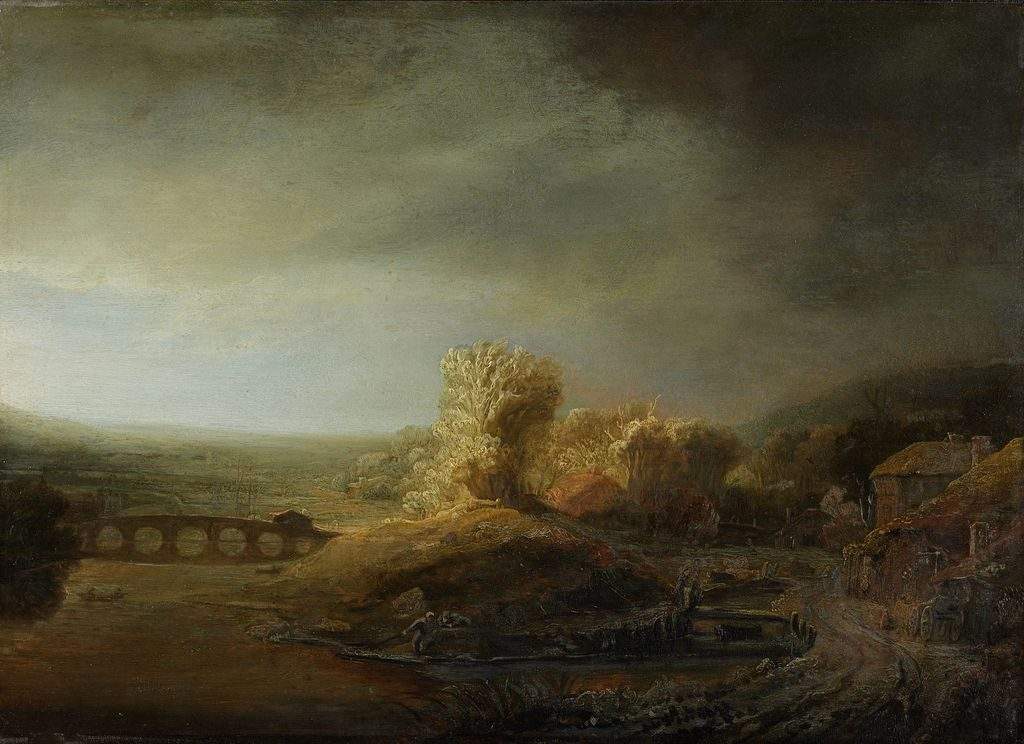It was thought for more than 30 years to be a painting by a pupil of Rembrandt van Rijn, but now new studies find that it is in fact a painting by the master. The work in question is the Landscape with Arched Bridge in the Gemäldegalerie in Berlin, which was believed to be the work of Govert Flinck, a pupil of Rembrandt: new research, however, has led German scholars to ascribe the painting to the great Dutch painter’s catalog. The painting will be displayed, starting April 8, 2022, in the exhibition David Hockney - Landscapes in Dialogue. The “Four Seasons” of the Würth Collection in Berlin, which puts works by contemporary painter David Hockney in dialogue with some works from the Berlin museum’s permanent collections.
When Landscape with Arch Bridge (inv. 1932) entered the Gemäldegalerie’s collection in 1924, it was still considered a work by Rembrandt. For Wilhelm von Bode, the then director general of the Royal Museums in Berlin and an internationally renowned Rembrandt specialist, the work’s entry into the collections went to fulfill a wish that the scholar had harbored for several decades, as the landscape filled a gap in the collection in his view and significantly complemented the museum’s core of Rembrandt works.
The painting came from the important collection of Grand Duke Frederick Augustus of Oldenburg (1852-1931), whose collection of paintings was dispersed in 1918 after his forced abdication. In September 1919, the now former grand duke had some 115 of his best works transported to the Netherlands, which then ended up at the auction house Frederik Muller & Cie in Amsterdam, which attempted to sell them. From there, a selection of 40 works moved to the United States in an attempt to place them with American collectors: among them, with attribution to Rembrandt, was Landscape with Arched Bridge. The work was not sold because of its high price and small size of 28.5 x 39.5 cm. In 1923 it passed to art dealers Paul Cassirer and Julius Böhler, and the following year the landscape was finally acquired in exchange for three works from the collection of the Kaiser Friedrich Museum: this was considered an extremely auspicious transaction for the Gemäldegalerie, as the museum no longer had sufficient funds to make such a high-profile purchase.
The Landscape with Arched Bridge was considered an autograph work by Rembrandt until the 1980s. After that, in 1989, an investigation by the Rembrandt Research Project expunged the painting from the autograph catalog and assigned it to one of Rembrandt’s main pupils, Govert Flinck, on stylistic grounds from comparisons with other works. However, recent examinations of the Berlin painting and the evaluation of technical photographs, which were unavailable in 1989, have now confirmed that the work was painted by the same artist, the museum notes. Indeed, it has been possible to identify changes and corrections in the painting that were made during its execution.According to the Gemäldegalerie, it is now possible to understand the development of the composition, with its masterful lighting and chiaroscuro contrasts. The Rijksmuseum in Amsterdam holds a similar work to the one in Berlin, the Landscape with Stone Bridge, which the Rembrandt Research Project considered to be an autograph: rather, the Gemäldegalerie, in light of the latest investigations, believes that, due to the scarce presence of alterations and repentances in the Dutch painting, it is, if anything, the Berlin painting that should be considered a precursor to the one in Amsterdam. “This conclusion,” the museum says in a note, “is supported by the dendrochronological findings, which indicate a later date of origin for the Amsterdam painting. Rembrandt’s major revisions to the Berlin work also explain the significant differences in the pictorial style of the two paintings. In the Berlin version it is relatively dense and compact, in the later Amsterdam version translucent and precise.”
Rembrandt painted very few landscapes, but these were very important works for later generations of artists. Through his masterfully staged and dramatically honed use of light, Rembrandt created atmospheres that had important effects on 17th-century Dutch landscape painting. Currently, only seven landscape paintings by Rembrandt are known. With the reattribution of the Berlin painting, this number now rises to eight works. The Gemäldegalerie has one of the world’s most important and extensive collections of works by Rembrandt van Rijn: with Landscape with Arched Bridge, this important nucleus now reaches 20 works.
The painting, as mentioned, will be on display from April 8, 2022 in the special exhibition David Hockney - Landscapes in Dialogue. The “Four Seasons” of the Würth Collection in Berlin, which will compare Hockney’s Four Seasons series with landscape images from the collections of the Gemäldegalerie, the Nationalgalerie, and the Kupferstichkabinett. The contribution that great artists of the past, such as John Constable, Vincent van Gogh, and Rembrandt himself, had on Hockney’s art will thus become evident.
Image: Rembrandt, Landscape with Arched Bridge (1638; oil on canvas, 28.5 x 39.5 cm; Berlin, Gemäldegalerie)
 |
| Berlin, a painting believed to be the work of a Rembrandt pupil has been assigned to the master |
Warning: the translation into English of the original Italian article was created using automatic tools. We undertake to review all articles, but we do not guarantee the total absence of inaccuracies in the translation due to the program. You can find the original by clicking on the ITA button. If you find any mistake,please contact us.